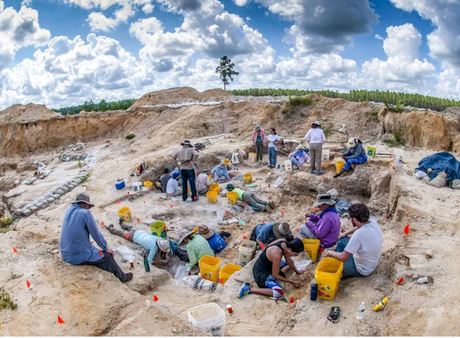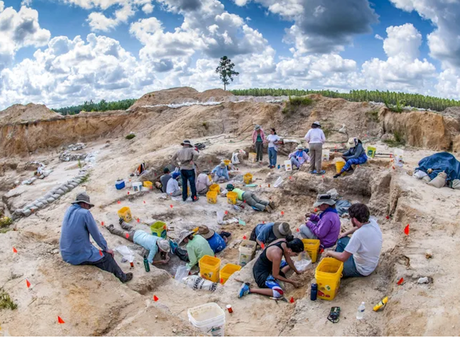We are paleontologists who focus our research on various types of fossils, including ancient horses. Our most recent work used computer statistics to analyze gaps in the fossil record to infer more about which horse species did and did not live in an ancient habitat in Florida.
Horses evolved as ecosystems changed
People have been collecting fossil horses throughout North America for centuries. Because horse fossils are abundant and widespread across the continent, scientists often point to the long lifespan of the horse family as evidence of long-term evolutionary changes.
Paleontologists like us, who study extinct mammals, almost never find complete skeletons. Instead, we focus on durable fossil teeth, which help us understand ancient diets, and on fossil limbs, which help clarify how these animals moved.
Horses are eating machines. In the wild today, they feed mainly on grasses that do not provide much nutrition, so they must consume large quantities to survive. The large teeth of modern horses and their ancestors are primarily adapted for grazing on sandy grass. They replaced the smaller teeth of more primitive horses that were adapted to browsing through soft leafy vegetation.
We know what horses ate millions of years ago by studying distinctive microscopic scratches, pits and other wear patterns on their teeth that formed when ancient horses chewed plant foods. And analyzes of carbon preserved in fossil teeth show that coexisting horse species ate different plants; some browsed on the leaves of shrubs and trees, some grazed on grass, and still others were mixed feeders.
The story continues
The change in tooth shape follows the change in dominant vegetation types in North America, from tropical forests subsequently giving way to the great expansion of open prairie grasslands. As climate and flora changed over millions of years, horses changed from largely forest-dwelling browsers to largely open grazers. Their teeth and feeding patterns adapted to the environment.
Another adaptation is visible in the feet of horses. Modern horses have one hoof toe on each foot. Many extinct fossil horses - the ancient ancestors of today's horses - had three toes per foot. The single toe on each elongated foot is good for fast and sustained running to avoid predators and for long-distance seasonal migrations. The older three-toed feet provided stability on unstable or wet ground. The adaptation from three toes to one was probably a response to changing habitats.
But even as the environment changed, one species did not completely replace another overnight. The fossil record in North America documents periods millions of years ago when multiple horse species coexisted in ancient landscapes. Species were of different sizes and had teeth equipped to chew different plants, so they did not compete directly with each other for the same food. Different habitats within these ancient ecosystems likely had some species more adapted to forests and others more adapted to grasslands.
Understanding Florida's fossil record
Paleontologists have been collecting horse fossils in Florida for more than 125 years. The University of Florida's Florida Museum of Natural History, where we work, has more than 70,000 fossil horse specimens from more than a thousand sites across the state.
One of our more productive fossil sites, Montbrook, offers a glimpse of a 5.8 million year old ancient streambed. More than thirty extinct mammals have been preserved, including rhinos, elephants and carnivores, as well as hundreds of bones and teeth from fossil horses.
Although six horse species are known elsewhere in Florida, we have only found four in Montbrook so far. This smaller number of horse species surprised us, so we decided to investigate. Did the two "missing" horse species really not live in Montbrook, or have scientists simply not discovered their fossil remains yet?
We designed a theoretical model that compares Montbrook, with only four horse species, to other fossil sites in Florida that contain all six. Using a statistical technique scientists call bootstrapping, our computer essentially simulated the continued collection of fossils over time. We generated 1,000 theoretical fossil collection events from the counts of fossil species at the sites where all six are present, to predict the probability of collecting the species currently missing from Montbrook.
The results of our simulation show that the two missing horse species at Montbrook were absent for various reasons. One of the horses will probably actually be absent; the other may still be discovered upon further excavation.


Investigating 'gaps' in the fossil record
Knowing that a species is absent is just as important as knowing when a species is present at a fossil site. Absences may be indicators of underlying ecological and biological factors that alter population dynamics. Combined with other types of analyses, researchers can apply these types of predictive models to many fossil species and ancient landscapes.
Ever since Charles Darwin proposed his theory of evolution, scientists have known that the fossil record is incomplete, resulting in gaps in our knowledge of the ancient past and in evolutionary changes. Paleontologists are challenged to explain these gaps, including which species were or were not present at particular fossil sites.
Holes can be created by certain materials, such as teeth and shells, which are often more durable than cancellous bone and fossilize better than others. Likewise, different chemical conditions during fossil collection, and even the amount of time spent collecting fossils at a particular location, can contribute to the lack of knowledge.
Fortunately, fossil horse teeth are quite well preserved and are often found. As new discoveries are made, such as those from our ongoing excavations in Florida, they will help clarify and narrow the gaps in the fossil record.
This article is republished from The Conversation, an independent nonprofit organization providing facts and analysis to help you understand our complex world.It was written by: Stephanie Killingsworth, University of Florida and Bruce J. MacFadden, University of Florida.
Read more: Bruce J. MacFadden receives funding from the US National Science Foundation. Stephanie Killingsworth does not work for, consult with, own shares in, or receive funding from any company or organization that would benefit from this article, and has disclosed no relevant affiliations beyond their academic appointment.